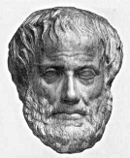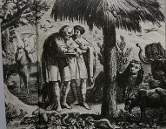Aristotelianism · 4535 dagen geleden by Ad van den Ende
Summary of volume I, § 19 to §49 of The Mechanization of the World Picture, written by E.J.Dijkstehuis
4. The Pythagoreans accorded supremacy to natural numbers and their proportions.
They observed the consonant musical intervals of the octave, the fifth and the fourth by the proportions 2 : 1, 3 : 2 and 4 : 3.
Aristotle did sum up the whole of the Pythagorean doctrine in the paradox: all things are numbers.
19. The whole of Aristotle’s philosophy is closely interwoven. It is hardly possible to explain a few details apart from their context.
Arstotle differred from earlier thinkers fundamentally in three ways.
a. Aristotle rejected Plato’s view that true being is to be found in a transcendental world of forms. The subject of science is formed by the things we perceive by our senses. Our mind has to elaborate these data.
b. In contrast with the course, chosen by the Atomists (a physical science of quantities), Aristotle wished to evolve a physical sience of qualities. Material bearers of properties were regarded as explanatory principles.
c. Parmenides said that being can’t arise from being (which is already, and consequently does not arise) neither from not-being (this does not exist). Aristotle answered that several meanings of the word ‘being’ have to be distinguished. The changes we observe in nature may made intelligible by a deeper analysis of the concept of being.
a. Substance and Accident, Matter and Form, Potentiality and Actuality
21. Substance denotes the being of every concrete, individually existing thing.
An accident is a being conditioned by something else. The accidents are inherent in the substance.
Form and Matter
The form of a thing is the total of the properties making this thing what it is. The matter of a thing is the possibility of acquiring a certain structure.
22. Form makes matter into substance.
23. Aristoteles makes a distinction between potentiality and actuality. A thing is potentially what it may become, it is actually what it is.
b. The concept of motion
24. Motion denotes every transition from potential to actual being. All natural events consist in a transition from potentiality to actuality. The subject-matter of science is change.
25. (…) local motion, i.e. change of place, already possesses in the Aristotelian system something of the predominant position it is later to take in physics; this is because it forms the basis of all the other kinds of motion.
c. The Doctrine of the Elements and the Theory of ‘Mixtio’
26.
Aristotle accorded an essential place in his system to the Eudoclean system of the four elements. These elements are characterized by the four possible combinations of two of the fundamental active qualities: dry and most, hot and cold.
The element earth is dry and cold, water is cold and moist, air is moist and hot, fire is hot and dry.
27. Each element may be transmitted into an other element, if a quality turns into its opposite, or if both qualities do so.
29. Each substance is assumed to possess its own characteristic smallest particles. These might be compared to the molecules of later chemistry.
d. Natural and Enforced Motions
30.
‘Omne quod movetur ab alio movetur’: all that moves is moved by something else. This ´motor´ must either be present in the ‘mobile’(moving body) or be in direct contact with it; ‘actio in distans’ (action at a distance) is excluded as inconceivable; a ‘motor’ must always be a ‘motor conjunctus’ (connected with the ‘mobile’).
Living beings move ‘a se’, by their own efforts; their soul (the vital principle) is the required principle of motion.
For the inanimate bodies we have to distinguish between natural and enforced motion.
A falling stone has a natural motion; a stone which is thrown undergoes an enforced motion.
A heavy body falls to the centre of the universe (the centre of the earth), because there it has its natural place. A light object (fire) falls upwards towards the lunar sphere, because up there it has its natural place. They move in that direction if they are not impeded.
31. The phenomenon of falling bodies (…) now raises three important questions:
1. What is the ‘aliud’ (the something else) which sets and keeps a falling body going?
2. How is it that one body falls a given distance in a shorter time than another?
3. What is the cause of the acceleration of falling bodies?
These are questions of such fundamental importance for the rise of classical physics that it may be said to have evolved largely from the attempt to answer them; there can be no better way of understanding the difference in character between ancient and classical science than by first seeing what Aristotle has to say on these questions.
About the frst question Aristotle did not make an unambiguous statement. Scholasticism had to study this problem anew.
As to the second question: the velocity of the falling body is proportional to the weight of the falling body, and inversely proportional to the density of the medium.
33. The velocity of a falling body increases during the fall. Aristotle does not give a clear explanation.
34. As to enforced motion: while a body is being thrown the ‘projector’ is at first still in contact with it, and so he himself functions as ‘motor conjunctus’. During this period he sets the adjacent layer of the medium in motion, together with the ‘projectum’, but (…) he also imparts to it a ‘virtus movens’, a power to set something else in motion (…). And this layer (…) then repeats the action of the original ‘projector’ (…): it sets the ‘projectum’ in motion and transfers motion as wel as ‘virtus movens’ to the next layer.
With every transfer the moving power is somewhat weakened. At last the body no longer acquires a ‘virtus movens’. The ‘projectum’ now proceeds to perform its natural motion.
35. A vehicle moves the more rapidly as it is pushed with greater force, and the more slowly in proportion to its weight. The motion is uniform as long as the force does not change. This may be called the fundamental law of Aristotelian dynamics and the historical counterpart of the fundamental law of motion of classical dynamics: a constant force imparts to the body on which it acts a uniform motion, the velocity of which is directly proportional to the force, and inversely proportional to the weight of the body.
Aristotle teached: ‘Omne quod movetur ab alio movetur’: all that moves is moved by something else, and if this ‘aliud’ is absent the motion comes immediately to an end.
Many centuries were to elapse before this complicated relationship was to be understood, before men learned to distinguish between inertia and gravity, between mass and weight, and in particular before they were to discover that the tendency to persist in the state once entered upon, which is called inertia, relates equally to the state of motion and the state of rest.
36. Aristotelian thought has the tendency to divide the moving force by the resistance, and never to subtract the latter from the former. This would impede the growth of classical mechanics seriously. This formulation had important consequences for the question about the possibility of a void too. (If R = 0 the denominator is zero!)
37. Aristotelian physics deals with concrete, observable situations.
But from a scientific point of view this very advantage constitutes its weakness, for these situations are so complicated (…) that even with the aid of perfected classical mechanics they can be treated only by approximation (…). The Aristotelian mode of thinking had to be supplemented by the Platonic to become truly fruitful.
But for dynamics this combination was at first achieved in the seventeenth century.
39. The motions of the terrestrial elements earth, water, air and fire are rectilineair. But the heavenly bodies describe circular motions. So there must be a fifth element, which describes by nature circular motions. this fifth element, the ether, has neither gravity nor levity, and can´t perish. So there is a fundamental antithesis between earth and heaven, between the world of stars and planets and the sublunary world.
e. The general world-picture
This picture is essentially geocentric in character: the earth is situated motionless at the centre of the universe, and the heavens revolve steadily about an axis passing through that centre.
Aristotle did know the world-pictures of earlier thinkers:
Philolaos: the earth revolves about a central fire;
Heraclides Ponticus: the earth describes an axial rotation and a circulair revolution.
Aristotle was a synthetic thinker. He would create an integral worldpicture, and did relate cosmology to physics and general philosophy. His theory of natural motion and natural place did define his cosmology.
42. In the realm οf mathematical astronomy Aristotle thus appears in all respects tο have followed the road indicated by Platο and first trodden by Eudoxos. This agreement between the two most influential thinkers οf Antiquity, who for the rest contradict each other οn sο many points, has had imporrtant consequences for the history οf astronomy. The axiom οf the uniformity and circularity οf the motions οf the heavenly bodies, which Plato had framed οn mathematical and religious grounds, had been supported by Aristotle with physical arguments and made an essential part οf his world-system; enunciated unanimously by two such authorίtative thinkers it was bound tο appeaτ beyond all doubt. Nor did astronomers venture to deviate from this view befοre the beginning οf the seventeenth century, and even then they only undertook this most reνοlutiοnary οf all changes in the ancient world-picture from sheer necessity.
43.
In connexion with the general principle οf Aristotelian philosophy, that every motion presupposes a motor, the question οf what causes the revolution οf the celestial spheres naturally arises.
Aristoteles does not follow Platο in his belief that the planets are living beings, gods, whο move by their own efforts. On the ground οf the perpetuity and immutability οf the celestial motions he does, however, come to the conclusion that the movers of the planetary spheres must be immaterial substances which, being all actuality and wholly devoid οf pοtentiality, cannot themselves be in motion. (…)
Aristotle was a good biologist.
Finally, for the motion οf the eighth sphere, the existence οf a supreme, immaterial Prime Mover is assumed. The Prime Mover, hοwever, does not set this sphere in motion by doing something Himself; that would be cοntrary to the fact that He is actus purus, and thus has nothing left tο realize; perfect actuality must consist in absolute inactivity. However, He moves the eight spehre, as the Aristotelian formula says, ώs έpώμενον, by being loved, i.e. the motion is the consequence οf the affection in which He is held by the matter οf the eighth sphere, οf the craving for perfection that
He arouses in it. This is in accordance with the general Aristotelian cοnception that matter aspires after form. It is not as passive as it may sometimes appear to be; the whole universe is pervaded by an aspiratiοn after greater perfection, οf which the Prime Mover is the ultimate aim. This aspiration causes a hierarchic arrangement οf bodies (elements, minerals plants, animals, man). It finds its consummation in man, because here matter is united with the most perfect form οf which it is capable: the soul.
In the discussion οf the immaterial movers οf the celestial spheres Aristotle’s astronomy develops into what Plato’s had been from the start: a rational theology, which informs us by rational means about the divine intelligences and their hierarchy.



